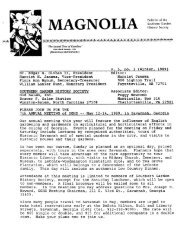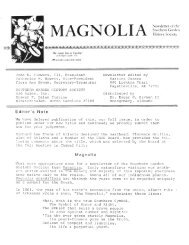Magnolia Newsletter Fall 04 - Southern Garden History Society
Magnolia Newsletter Fall 04 - Southern Garden History Society
Magnolia Newsletter Fall 04 - Southern Garden History Society
You also want an ePaper? Increase the reach of your titles
YUMPU automatically turns print PDFs into web optimized ePapers that Google loves.
REVIEW…<br />
(continued from page 14)<br />
on to the daffodils that were considered marginal in the FDS<br />
test gardens, ending with a short guide for identifying<br />
daffodils by foliage. The guide finishes with a series of<br />
appendices that show what survived and what did not<br />
survive in the FDS test gardens, a listing of cultivars growing<br />
in the central Florida test gardens, companion bulbs and<br />
plants, for daffodils, and lastly a botanical description of the<br />
species and intersectional hybrids.<br />
Daffodils in Florida should become an invaluable<br />
reference and resource for anyone, gardeners and nongardeners<br />
alike, who enjoy daffodils and want to have them<br />
in the Coastal South and I strongly suspect that there are<br />
some lessons here for those of us who garden in the Mid-<br />
Atlantic region as well.<br />
—Don McKelvey, <strong>Garden</strong> Historian, Colonial<br />
Williamsburg<br />
Progress on the Historic American Landscapes Survey (HALS)<br />
By Cari Goetcheus, Chair, HALS Subcommittee<br />
American <strong>Society</strong> of Landscape Architects (ASLA),<br />
Historic Preservation Professional Interest Group<br />
Over twenty years in the making, October 25, 2000 was<br />
a monumental day in the field of landscape preservation. On<br />
that day the Director of the National Park Service<br />
permanently established the Historic American Landscapes<br />
Survey (HALS), as a sister program to the Historic American<br />
Buildings Survey (HABS) and the Historic American<br />
Engineering Record (HAER). HALS is intended to<br />
document significant historic landscapes throughout the<br />
United States via narrative history, drawings and<br />
photography.<br />
Similar to the HABS/HAER approach, teams of<br />
students, as well as interested professionals in landscape<br />
architecture, architecture, planning, horticulture, and<br />
associated fields will conduct fieldwork for HALS in shortterm<br />
projects. Guided by HALS documentation<br />
professionals, the participants will record significant historic<br />
landscapes nationwide through historical research and<br />
reports, measured and interpretive drawings and largeformat<br />
photography as well as other documentation<br />
techniques.<br />
As the primary force behind the development of HALS<br />
to date, the ASLA Historic Preservation Professional Interest<br />
Group, HALS Subcommittee has led several key projects to<br />
benefit the national HALS program, including:<br />
• Developed an educational/fundraising brochure.<br />
• Created a Memorandum of Agreement between the<br />
National Park Service, Library of Congress and ASLA<br />
to cooperatively develop the HALS program.<br />
• Created a private donations account at the<br />
HABS/HAER/HALS Foundation.<br />
• Received a $20,000 grant from the National Center for<br />
Preservation Technology and Training. The money<br />
was used to sponsor three national interdisciplinary<br />
workshops to brainstorm on the content of HALS<br />
Landscape Documentation Guidelines.<br />
• Beginning to identify historic landscapes nationwide<br />
that merit HALS documentation. The intent of this<br />
effort is to provide the national HALS program with a<br />
list of prescreened sites as potential HALS<br />
documentation projects.<br />
• Hired consultants to write the HALS Landscape<br />
Documentation Guidelines for Historical Research<br />
and Reports, Drawings and Photography.<br />
(Completion in March 2005)<br />
• Since 2000 ASLA has continuously lobbied Congress<br />
for permanent funding of the national HALS<br />
program. In 20<strong>04</strong> ASLA successfully lobbied Congress<br />
and there is currently $189,000 identified for the<br />
national HALS program in the Senate Appropriations<br />
Committee bill (unresolved).<br />
Although many successes have occurred on behalf of<br />
HALS, there are still two primary challenges: identification<br />
of significant historic landscapes nationwide and funding.<br />
The location, duration, and complexity of HALS<br />
projects will be determined on the basis of historic<br />
significance, landscape type and potential partnership<br />
opportunities. HALS will work with ASLA, state, local and<br />
national preservation organizations, academic institutions<br />
and other interested parties to identify and develop projects,<br />
exploring funding possibilities for both short and long-term<br />
documentation efforts. HALS encourages partnerships with<br />
private, government and educational institutions to develop<br />
landscape documentation and encourage landscape<br />
preservation. To assist in identifying potential HALS<br />
documentation sites, please contact Cari Goetcheus<br />
(clg2964@netzero.net).<br />
Although ASLA is leading the effort on federal funding,<br />
private donations, gifts and grants have been the primary<br />
funds received to date. To donate to the newly established<br />
HALS fund, make a tax-deductible contribution to the<br />
“HABS/HAER/HALS Foundation” (noting “HALS<br />
Donation” in the memo line), and mail to:<br />
HALS Donation<br />
HABS/HAER/HALS Foundation<br />
National Building Museum<br />
441 F Street, NW, Suite 312<br />
Washington, DC 20001-2728<br />
For more information on HALS, visit the ASLA Historic<br />
Preservation Professional Interest Group Web site<br />
(http://host.asla.org/groups/hppigroup/), or email specific<br />
questions or comments to hals@asla.org.<br />
Vol. XIX, No. 3 <strong>Magnolia</strong> • <strong>Fall</strong> 20<strong>04</strong> 15
















